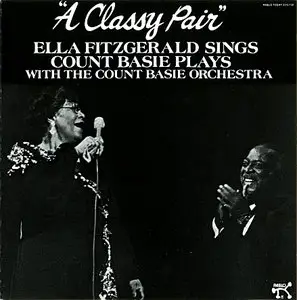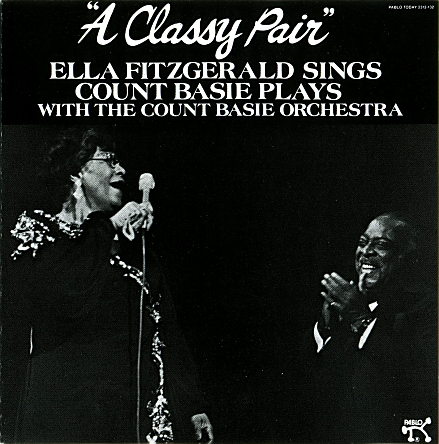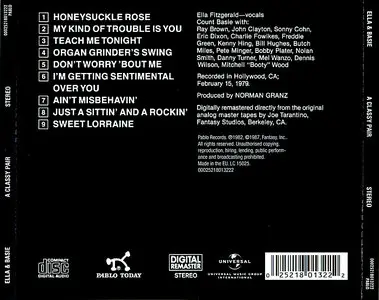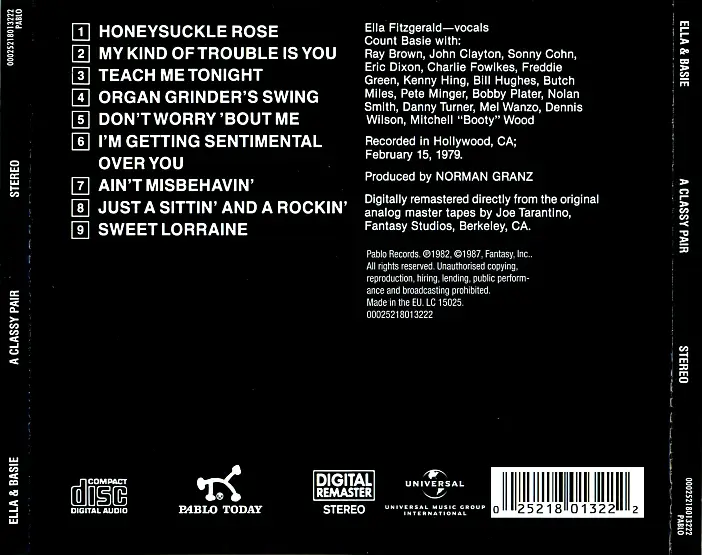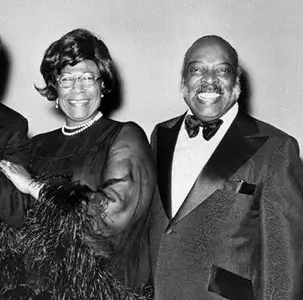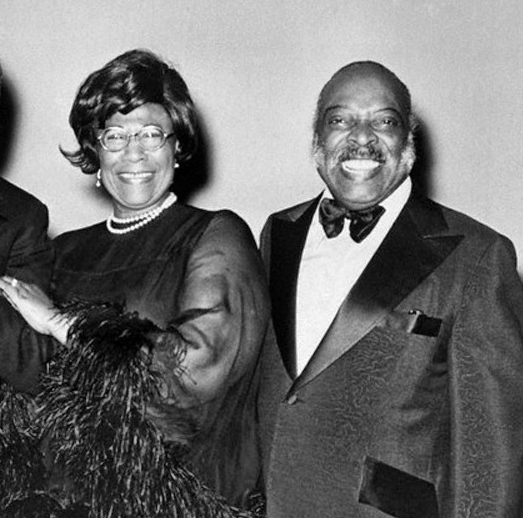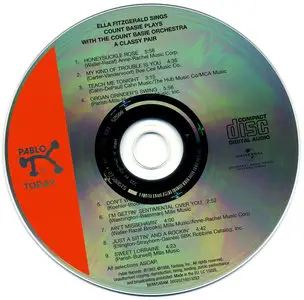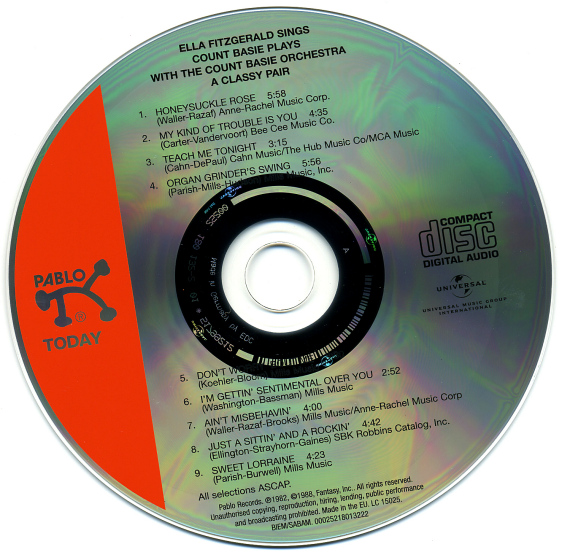Ella Fitzgerald & Count Basie - A Classy Pair (1991)
Jazz (Vocal) | EAC Rip | FLAC (image)+CUE+LOG | mp3@320 | 227 MB. & 106 MB.
300dpi. Complete Scans (JPG) included | WinRar, 3% recovery
Audio CD (1991) | Label: Pablo Today | Catalog# 0002521-8013222 | 40:16 min.
Jazz (Vocal) | EAC Rip | FLAC (image)+CUE+LOG | mp3@320 | 227 MB. & 106 MB.
300dpi. Complete Scans (JPG) included | WinRar, 3% recovery
Audio CD (1991) | Label: Pablo Today | Catalog# 0002521-8013222 | 40:16 min.
~cduniverseTracklist:
"A Classy Pair" is a most apt title for this session, which features Ella Fitzgerald and the final incarnation of the Count Basie Orchestra, perhaps the last major big band to exist under the baton of its namesake. Recorded in February 1979 and produced by the legendary Norman Granz, these nine tracks show Fitzgerald in a somewhat better light than the orchestra. Still in exquisite voice though in her early 60s, Fitzgerald shines throughout, from the opening "Honeysuckle Rose" through to the closing "Sweet Lorraine."
Her particular highlight is a swinging, saucy "Ain't Misbehavin'," featuring a breathtaking scat solo. Featuring no particularly outstanding soloists other than Basie himself, who does take several excellent choruses, the Basie Orchestra provides entirely competent but not exactly inspiring backing. Fitzgerald's vocals more than make up for the occasional weaknesses of her settings, however.
01. Honeysuckle Rose (6:14)
02. My Kind of Trouble is You (4:41)
03. Teach Me Tonight (3:23)
04. Organ Grinder's Swing (6:04)
05. Don't Worry 'bout Me (3:38)
06. I'm Getting Sentimental Over You (2:57)
07. Ain't Misbehavin' (4:03)
08. Just a Sittin' and a Rockin' (4:49)
09. Sweet Lorraine (4:26)
Personnel:
Ella Fitzgerald - vocals
Count Basie - piano
Pete Minger, Sonny Cohn, Ray Brown, Nolan Smith - trumpets
Mel Wanzo, Bill Hughes, 'Booty' Wood, Dennis Wilson - trombones
Bobby Plater, Danny Turner, Kenny Hing, Eric Dixon, Charlie Fowlkes - saxophones
John Clayton - bass
Freddie Green - guitar
Butch Miles - drums
~allAboutJazz
Born: April 25, 1917 | Died: June 15, 1996 | Instrument: Vocal
Dubbed “The First Lady of Song,” Ella Fitzgerald was the most popular female jazz singer in the United States for more than half a century. In her lifetime, she won 13 Grammy awards and sold over 40 million albums.
Her voice was flexible, wide-ranging, accurate and ageless. She could sing sultry ballads, sweet jazz and imitate every instrument in an orchestra. She worked with all the jazz greats, from Duke Ellington, Count Basie and Nat King Cole, to Frank Sinatra, Dizzy Gillespie and Benny Goodman. (Or rather, some might say all the jazz greats had the pleasure of working with Ella.)
She performed at top venues all over the world, and packed them to the hilt. Her audiences were as diverse as her vocal range. They were rich and poor, made up of all races, all religions and all nationalities. In fact, many of them had just one binding factor in common - they all loved her.
Humble but Happy Beginnings
Ella Jane Fitzgerald was born in Newport News, Virginia on April 25, 1917. Her father, William, and mother, Temperance (Tempie), parted ways shortly afterward. Tempie and Ella went to Yonkers, New York, where they eventually moved in with Tempie's longtime boyfriend Joseph Da Silva. Ella's half-sister, Frances, was born in 1923, and soon she began referring to Joe as her stepfather.
To support the family, Joe dug ditches and was a part-time chauffeur, while Tempie worked at a laundry mat and did some catering. Occasionally, Ella took on small jobs to contribute money as well. Perhaps naïve to the circumstances, Ella worked as a runner for local gamblers, picking up their bets and dropping off money.
Their apartment was in a mixed neighborhood, where Ella made friends easily. She considered herself more of a tomboy, and often joined in the neighborhood games of baseball. Sports aside, she enjoyed dancing and singing with her friends, and some evenings they would take the train into Harlem and watch various acts at the Apollo Theater.
A Rough Patch
In 1932, Tempie died from serious injuries she received in a car accident. Ella took the loss very hard. After staying with Joe for a short time, Tempie's sister Virginia took Ella home. Shortly afterward Joe suffered a heart attack and died, and her little sister Frances joined them.
Unable to adjust to the new circumstances, Ella became increasingly unhappy and entered into a difficult period of her life. Her grades dropped dramatically, and she frequently skipped school. After getting into trouble with the police, she was taken into custody and sent to a reform school. Living there was even more unbearable, as she suffered beatings at the hands of her caretakers.
Eventually Ella escaped from the reformatory. The fifteen-year-old found herself broke and alone during the Great Depression, and strove to endure.
Never one to complain, Ella later reflected on her most difficult years with an appreciation for how they helped her to mature. She used the memories from these times to help gather emotions for performances, and felt she was more grateful for her success because she knew what it was like to struggle in life.
“What's She Going to Do?”
In 1934 Ella's name was pulled in a weekly drawing at the Apollo and she won the opportunity to compete in Amateur Night. Ella went to the theater that night planning to dance, but when the frenzied Edwards Sisters closed the main show, Ella changed her mind. “They were the dancingest sisters around,” said Ella, and she felt her act would not compare.
Once on stage, faced with boos and murmurs of “What's she going to do?” from the rowdy crowd, a scared and disheveled Ella made the last minute decision to sing. She asked the band to play Hoagy Carmichael's Judy, a song she knew well because Connee Boswell's rendition of it was among Tempie's favorites. Ella quickly quieted the audience, and by the song's end they were demanding an encore. She obliged and sang the flip side of the Boswell Sister's record, The Object of My Affections.
Offstage, and away from people she knew well, Ella was shy and reserved. She was self-conscious about her appearance, and for a while even doubted the extent of her abilities. Onstage, however, Ella was surprised to find she had no fear. She felt at home in the spotlight.
“Once up there, I felt the acceptance and love from my audience,” said Ella. “I knew I wanted to sing before people the rest of my life.”
In the band that night was saxophonist and arranger Benny Carter. Impressed with her natural talent, he began introducing Ella to people who could help launch her career. In the process he and Ella became lifelong friends, often working together.
Fueled by enthusiastic supporters, Ella began entering - and winning - every talent show she could find. In January 1935 she won the chance to perform for a week with the Tiny Bradshaw band at the Harlem Opera House. It was there that Ella first met drummer and bandleader Chick Webb. Although her voice impressed him, Chick had already hired male singer Charlie Linton for the band. He offered Ella the opportunity to test with his band when they played a dance at Yale University. “If they kids like her,” said Chick, “she stays.” Despite the tough crowd, Ella was a major success, and Chick hired her to travel with the band for $12.50 a week.
Jazzing Things Up
In mid 1936, Ella made her first recording. Love and Kisses was released under the Decca label, with moderate success. By this time she was performing with Chick's band at the prestigious Harlem's Savoy Ballroom, often referred to as “The World's Most Famous Ballroom.”
Shortly afterward, Ella began singing a rendition of the song, (If You Can't Sing It) You Have to Swing It. During this time, the era of big swing bands was shifting, and the focus was turning more toward bebop. Ella played with the new style, often using her voice to take on the role of another horn in the band. You Have to Swing It was one of the first times she began experimenting with scat singing, and her improvisation and vocalization thrilled fans. Throughout her career, Ella would master scat singing, turning it into a form of art.
In 1938, at the age of 21, Ella recorded a playful version of the nursery rhyme, A-Tisket, A-Tasket. The album sold one million copies, hit number one, and stayed on the pop charts for 17 weeks. Suddenly, Ella Fitzgerald was famous.
Biography Coming into Her Own
On June 16, 1939, Ella mourned the loss of her mentor Chick Webb. In his absence the band was renamed “Ella Fitzgerald and her Famous Band,” and she took on the overwhelming task of bandleader.
Perhaps in search of stability and protection, Ella married Benny Kornegay, a local dockworker who had been pursuing her. Upon learning that Kornegay had a criminal history, Ella realized that the relationship was a mistake and had the marriage annulled.
While on tour with Dizzy Gillespie's band in 1946, Ella fell in love with bassist Ray Brown. The two were married and eventually adopted a son, who they named Ray, Jr.
At the time Ray was working for producer and manager Norman Granz in “Jazz at the Philharmonic” tour. Norman saw that Ella had what it took to be an international star, and he convinced Ella to sign with him. It was the beginning of a lifelong business relationship and friendship.
Under Norman's management, Ella joined the Philharmonic tour, worked with Louis Armstrong on several albums and began producing her infamous songbook series. From 1956-1964, she recorded covers of other musicians' albums, including those by Cole Porter, Duke Ellington, the Gershwins, Johnny Mercer, Irving Berlin, and Rodgers and Hart. The series was wildly popular, both with Ella's fans and the artists she covered. “I never knew how good our songs were until I heard Ella Fitzgerald sing them,” Ira Gershwin once remarked.
Ella also began appearing on television variety shows. She quickly became a favorite and frequent guest on numerous programs, including The Bing Crosby Show, The Dinah Shore Show, The Frank Sinatra Show, The Ed Sullivan Show, The Tonight Show, The Nat King Cole Show, The Andy Willams Show and The Dean Martin Show.
Due to a busy touring schedule, Ella and Ray were often away from home, straining the bond with their son. Ultimately, Ray Jr. and Ella reconnected and mended their relationship. “All I can say is that she gave to me as much as she could,” Ray, Jr. later said, “and she loved me as much as she could.”
Unfortunately, busy work schedules also hurt Ray and Ella's marriage. The two divorced in 1952, but remained good friends for the rest of their lives.
Overcoming Discrimination
On the touring circuit it was well-known that Ella's manager felt very strongly about civil rights and required equal treatment for his musicians, regardless of their color. Norman refused to accept any type of discrimination at hotels, restaurants or concert halls, even when they traveled to the Deep South. Once, while in Dallas touring for the Philharmonic, a police squad irritated by Norman's principles barged backstage to hassle the performers. They came into Ella's dressing room, where band members Dizzy Gillespie and Illinois Jacquet were shooting dice, and arrested everyone. “They took us down,” Ella later recalled, “and then when we got there, they had the nerve to ask for an autograph.”
Norman wasn't the only one willing to stand up for Ella. She received support from numerous celebrity fans, including a zealous Marilyn Monroe.
“I owe Marilyn Monroe a real debt,” Ella later said. “It was because of her that I played the Mocambo, a very popular nightclub in the '50s. She personally called the owner of the Mocambo, and told him she wanted me booked immediately, and if he would do it, she would take a front table every night. She told him - and it was true, due to Marilyn's superstar status - that the press would go wild. The owner said yes, and Marilyn was there, front table, every night. The press went overboard…. After that, I never had to play a small jazz club again. She was an unusual woman - a little ahead of her times. And she didn't know it.”
Worldwide Recognition
Ella continued to work as hard as she had early on in her career, despite the ill effects on her health. She toured all over the world, sometimes performing two shows a day in cities hundreds of miles apart. In 1974, Ella spent a legendary two weeks performing in New York with Frank Sinatra and Count Basie. Still going strong five years later, she was inducted into the Down Beat magazine Hall of Fame, and received Kennedy Center Honors for her continuing contributions to the arts.
Outside of the arts, Ella had a deep concern for child welfare. Though this aspect of her life was rarely publicized, she frequently made generous donations to organizations for disadvantaged youths, and the continuation of these contributions was part of the driving force that prevented her from slowing down. Additionally, when Frances died, Ella felt she had the additional responsibilities of taking care of her sister's family.
In 1987, United States President Ronald Reagan awarded Ella the National Medal of Arts. It was one of her most prized moments. France followed suit several years later, presenting her with their Commander of Arts and Letters award, while Yale, Dartmouth and several other universities bestowed Ella with honorary doctorates.
End of an Era
In September of 1986, Ella underwent quintuple coronary bypass surgery. Doctors also replaced a valve in her heart and diagnosed her with diabetes, which they blamed for her failing eyesight. The press carried rumors that she would never be able to sing again, but Ella proved them wrong. Despite protests by family and friends, including Norman, Ella returned to the stage and pushed on with an exhaustive schedule.
By the 1990s, Ella had recorded over 200 albums. In 1991, she gave her final concert at New York's renowned Carnegie Hall. It was the 26th time she performed there.
As the effects from her diabetes worsened, 76-year-old Ella experienced severe circulatory problems and was forced to have both of her legs amputated below the knees. She never fully recovered from the surgery, and afterward, was rarely able to perform. During this time, Ella enjoyed sitting outside in her backyard, and spending time with Ray, Jr. and her granddaughter Alice. “I just want to smell the air, listen to the birds and hear Alice laugh,” she said.
On June 15, 1996, Ella Fitzgerald died in her Beverly Hills home. Hours later, signs of remembrance began to appear all over the world. A wreath of white flowers stood next to her star on the Hollywood Walk of Fame, and a marquee outside the Hollywood Bowl theater read, “Ella, we will miss you.”
After a private memorial service, traffic on the freeway was stopped to let her funeral procession pass through. She was laid to rest in the “Sanctuary of the Bells” section of the Sunset Mission Mausoleum at Inglewood Park Cemetery in Inglewood, California.
Born: April 25, 1917 | Died: June 15, 1996 | Instrument: Vocal
Dubbed “The First Lady of Song,” Ella Fitzgerald was the most popular female jazz singer in the United States for more than half a century. In her lifetime, she won 13 Grammy awards and sold over 40 million albums.
Her voice was flexible, wide-ranging, accurate and ageless. She could sing sultry ballads, sweet jazz and imitate every instrument in an orchestra. She worked with all the jazz greats, from Duke Ellington, Count Basie and Nat King Cole, to Frank Sinatra, Dizzy Gillespie and Benny Goodman. (Or rather, some might say all the jazz greats had the pleasure of working with Ella.)
She performed at top venues all over the world, and packed them to the hilt. Her audiences were as diverse as her vocal range. They were rich and poor, made up of all races, all religions and all nationalities. In fact, many of them had just one binding factor in common - they all loved her.
Humble but Happy Beginnings
Ella Jane Fitzgerald was born in Newport News, Virginia on April 25, 1917. Her father, William, and mother, Temperance (Tempie), parted ways shortly afterward. Tempie and Ella went to Yonkers, New York, where they eventually moved in with Tempie's longtime boyfriend Joseph Da Silva. Ella's half-sister, Frances, was born in 1923, and soon she began referring to Joe as her stepfather.
To support the family, Joe dug ditches and was a part-time chauffeur, while Tempie worked at a laundry mat and did some catering. Occasionally, Ella took on small jobs to contribute money as well. Perhaps naïve to the circumstances, Ella worked as a runner for local gamblers, picking up their bets and dropping off money.
Their apartment was in a mixed neighborhood, where Ella made friends easily. She considered herself more of a tomboy, and often joined in the neighborhood games of baseball. Sports aside, she enjoyed dancing and singing with her friends, and some evenings they would take the train into Harlem and watch various acts at the Apollo Theater.
A Rough Patch
In 1932, Tempie died from serious injuries she received in a car accident. Ella took the loss very hard. After staying with Joe for a short time, Tempie's sister Virginia took Ella home. Shortly afterward Joe suffered a heart attack and died, and her little sister Frances joined them.
Unable to adjust to the new circumstances, Ella became increasingly unhappy and entered into a difficult period of her life. Her grades dropped dramatically, and she frequently skipped school. After getting into trouble with the police, she was taken into custody and sent to a reform school. Living there was even more unbearable, as she suffered beatings at the hands of her caretakers.
Eventually Ella escaped from the reformatory. The fifteen-year-old found herself broke and alone during the Great Depression, and strove to endure.
Never one to complain, Ella later reflected on her most difficult years with an appreciation for how they helped her to mature. She used the memories from these times to help gather emotions for performances, and felt she was more grateful for her success because she knew what it was like to struggle in life.
“What's She Going to Do?”
In 1934 Ella's name was pulled in a weekly drawing at the Apollo and she won the opportunity to compete in Amateur Night. Ella went to the theater that night planning to dance, but when the frenzied Edwards Sisters closed the main show, Ella changed her mind. “They were the dancingest sisters around,” said Ella, and she felt her act would not compare.
Once on stage, faced with boos and murmurs of “What's she going to do?” from the rowdy crowd, a scared and disheveled Ella made the last minute decision to sing. She asked the band to play Hoagy Carmichael's Judy, a song she knew well because Connee Boswell's rendition of it was among Tempie's favorites. Ella quickly quieted the audience, and by the song's end they were demanding an encore. She obliged and sang the flip side of the Boswell Sister's record, The Object of My Affections.
Offstage, and away from people she knew well, Ella was shy and reserved. She was self-conscious about her appearance, and for a while even doubted the extent of her abilities. Onstage, however, Ella was surprised to find she had no fear. She felt at home in the spotlight.
“Once up there, I felt the acceptance and love from my audience,” said Ella. “I knew I wanted to sing before people the rest of my life.”
In the band that night was saxophonist and arranger Benny Carter. Impressed with her natural talent, he began introducing Ella to people who could help launch her career. In the process he and Ella became lifelong friends, often working together.
Fueled by enthusiastic supporters, Ella began entering - and winning - every talent show she could find. In January 1935 she won the chance to perform for a week with the Tiny Bradshaw band at the Harlem Opera House. It was there that Ella first met drummer and bandleader Chick Webb. Although her voice impressed him, Chick had already hired male singer Charlie Linton for the band. He offered Ella the opportunity to test with his band when they played a dance at Yale University. “If they kids like her,” said Chick, “she stays.” Despite the tough crowd, Ella was a major success, and Chick hired her to travel with the band for $12.50 a week.
Jazzing Things Up
In mid 1936, Ella made her first recording. Love and Kisses was released under the Decca label, with moderate success. By this time she was performing with Chick's band at the prestigious Harlem's Savoy Ballroom, often referred to as “The World's Most Famous Ballroom.”
Shortly afterward, Ella began singing a rendition of the song, (If You Can't Sing It) You Have to Swing It. During this time, the era of big swing bands was shifting, and the focus was turning more toward bebop. Ella played with the new style, often using her voice to take on the role of another horn in the band. You Have to Swing It was one of the first times she began experimenting with scat singing, and her improvisation and vocalization thrilled fans. Throughout her career, Ella would master scat singing, turning it into a form of art.
In 1938, at the age of 21, Ella recorded a playful version of the nursery rhyme, A-Tisket, A-Tasket. The album sold one million copies, hit number one, and stayed on the pop charts for 17 weeks. Suddenly, Ella Fitzgerald was famous.
Biography Coming into Her Own
On June 16, 1939, Ella mourned the loss of her mentor Chick Webb. In his absence the band was renamed “Ella Fitzgerald and her Famous Band,” and she took on the overwhelming task of bandleader.
Perhaps in search of stability and protection, Ella married Benny Kornegay, a local dockworker who had been pursuing her. Upon learning that Kornegay had a criminal history, Ella realized that the relationship was a mistake and had the marriage annulled.
While on tour with Dizzy Gillespie's band in 1946, Ella fell in love with bassist Ray Brown. The two were married and eventually adopted a son, who they named Ray, Jr.
At the time Ray was working for producer and manager Norman Granz in “Jazz at the Philharmonic” tour. Norman saw that Ella had what it took to be an international star, and he convinced Ella to sign with him. It was the beginning of a lifelong business relationship and friendship.
Under Norman's management, Ella joined the Philharmonic tour, worked with Louis Armstrong on several albums and began producing her infamous songbook series. From 1956-1964, she recorded covers of other musicians' albums, including those by Cole Porter, Duke Ellington, the Gershwins, Johnny Mercer, Irving Berlin, and Rodgers and Hart. The series was wildly popular, both with Ella's fans and the artists she covered. “I never knew how good our songs were until I heard Ella Fitzgerald sing them,” Ira Gershwin once remarked.
Ella also began appearing on television variety shows. She quickly became a favorite and frequent guest on numerous programs, including The Bing Crosby Show, The Dinah Shore Show, The Frank Sinatra Show, The Ed Sullivan Show, The Tonight Show, The Nat King Cole Show, The Andy Willams Show and The Dean Martin Show.
Due to a busy touring schedule, Ella and Ray were often away from home, straining the bond with their son. Ultimately, Ray Jr. and Ella reconnected and mended their relationship. “All I can say is that she gave to me as much as she could,” Ray, Jr. later said, “and she loved me as much as she could.”
Unfortunately, busy work schedules also hurt Ray and Ella's marriage. The two divorced in 1952, but remained good friends for the rest of their lives.
Overcoming Discrimination
On the touring circuit it was well-known that Ella's manager felt very strongly about civil rights and required equal treatment for his musicians, regardless of their color. Norman refused to accept any type of discrimination at hotels, restaurants or concert halls, even when they traveled to the Deep South. Once, while in Dallas touring for the Philharmonic, a police squad irritated by Norman's principles barged backstage to hassle the performers. They came into Ella's dressing room, where band members Dizzy Gillespie and Illinois Jacquet were shooting dice, and arrested everyone. “They took us down,” Ella later recalled, “and then when we got there, they had the nerve to ask for an autograph.”
Norman wasn't the only one willing to stand up for Ella. She received support from numerous celebrity fans, including a zealous Marilyn Monroe.
“I owe Marilyn Monroe a real debt,” Ella later said. “It was because of her that I played the Mocambo, a very popular nightclub in the '50s. She personally called the owner of the Mocambo, and told him she wanted me booked immediately, and if he would do it, she would take a front table every night. She told him - and it was true, due to Marilyn's superstar status - that the press would go wild. The owner said yes, and Marilyn was there, front table, every night. The press went overboard…. After that, I never had to play a small jazz club again. She was an unusual woman - a little ahead of her times. And she didn't know it.”
Worldwide Recognition
Ella continued to work as hard as she had early on in her career, despite the ill effects on her health. She toured all over the world, sometimes performing two shows a day in cities hundreds of miles apart. In 1974, Ella spent a legendary two weeks performing in New York with Frank Sinatra and Count Basie. Still going strong five years later, she was inducted into the Down Beat magazine Hall of Fame, and received Kennedy Center Honors for her continuing contributions to the arts.
Outside of the arts, Ella had a deep concern for child welfare. Though this aspect of her life was rarely publicized, she frequently made generous donations to organizations for disadvantaged youths, and the continuation of these contributions was part of the driving force that prevented her from slowing down. Additionally, when Frances died, Ella felt she had the additional responsibilities of taking care of her sister's family.
In 1987, United States President Ronald Reagan awarded Ella the National Medal of Arts. It was one of her most prized moments. France followed suit several years later, presenting her with their Commander of Arts and Letters award, while Yale, Dartmouth and several other universities bestowed Ella with honorary doctorates.
End of an Era
In September of 1986, Ella underwent quintuple coronary bypass surgery. Doctors also replaced a valve in her heart and diagnosed her with diabetes, which they blamed for her failing eyesight. The press carried rumors that she would never be able to sing again, but Ella proved them wrong. Despite protests by family and friends, including Norman, Ella returned to the stage and pushed on with an exhaustive schedule.
By the 1990s, Ella had recorded over 200 albums. In 1991, she gave her final concert at New York's renowned Carnegie Hall. It was the 26th time she performed there.
As the effects from her diabetes worsened, 76-year-old Ella experienced severe circulatory problems and was forced to have both of her legs amputated below the knees. She never fully recovered from the surgery, and afterward, was rarely able to perform. During this time, Ella enjoyed sitting outside in her backyard, and spending time with Ray, Jr. and her granddaughter Alice. “I just want to smell the air, listen to the birds and hear Alice laugh,” she said.
On June 15, 1996, Ella Fitzgerald died in her Beverly Hills home. Hours later, signs of remembrance began to appear all over the world. A wreath of white flowers stood next to her star on the Hollywood Walk of Fame, and a marquee outside the Hollywood Bowl theater read, “Ella, we will miss you.”
After a private memorial service, traffic on the freeway was stopped to let her funeral procession pass through. She was laid to rest in the “Sanctuary of the Bells” section of the Sunset Mission Mausoleum at Inglewood Park Cemetery in Inglewood, California.
~allAboutJazz
Born: August 21, 1904 | Died: April 26, 1984 | Instrument: Piano
Bill Basie studied music with his mother as a child and played piano in early childhood. He picked up the basics of early ragtime from some of the great Harlem pianists and studied organ informally with Fats Waller. He made his professional debut as an accompanist for vaudeville acts and replaced Waller in an act called Katie Crippen and her Kids. He also worked with June Clark and Sonny Greer who was later to become Duke Ellington’s drummer.
It was while traveling with the Gonzel White vaudeville show that Basie became stranded in Kansas City when the outfit suddenly broke up. He played at a silent movie house for a while and then became a member of the Walter Page Blue Devils in 1928 and ’29. Included in the ranks of the Blue Devils was a blues shouter who was later to play a key role as early male vocalist with Basie’s own big band, Jimmy Rushing. It was in fact the rotund Rushing who happened to hear Basie playing in Kansas City and invited him to attend a Blue Devil's performance. Basie soon joined the band after sitting in with them that night.
After Page's Blue Devils broke up Count Basie and some of the other band members integrated into the Bennie Moten band. He remained with Moten until his death in 1935. After Moten’s death the band continued under the leadership of Bennie’s brother Buster, but Basie started a group of his own and soon found a steady gig at the Reno Club in Kansas City employing some of the best personnel from the Moten band himself.
The band gradually built up in quantity and quality of personnel and was broadcast live regularly from the club by a small Kansas City radio station. It was during one of these broadcasts that the group was heard by John Hammond, a wealthy jazz aficionado, who had himself worked as an announcer, disc jockey and producer of a live jazz show on radio. Hammond decided that the band must go to New York. Through his efforts and support (at times even financially) the band enlarged its membership further and went to New York in 1936. Hammond installed Willard Alexander as the band’s manager and in January of 1937 the Count Basie band made its first recording with the Decca record label.
By the following year the Basie big band had become internationally famous, anchored by the leader’s simple and sparse piano style and the rhythm section of Freddie Greene guitar, Walter Page bass, and Jo Jones drums. The great soloists of this band included Jimmy Rushing as vocalist, Lester Young and Herschel Evans tenor saxes, Earl Warren on alto, Buck Clayton and Harry “Sweets” Edison on trumpets, and Benny Morton and Dickie Wells on trombones, among others. Also contributing to the bands success were the arrangements by Eddie Durham and others in the band and the “head” arrangements spontaneously developed by the group.
Despite the occasional losses of key soloists, throughout the 1940’s Basie maintained a big band that possessed an infectious rhythmic beat, an enthusiastic team spirit, and a long list of inspired and talented jazz soloists. Among the long line of budding stars to pass through the Basie aggregation's ranks during these years were tenor men, Lester Young, Herschel Evans, Don Byas, Buddy Tate, Lucky Thompson, Illinois Jacquet, and Paul Gonsalves. On trumpets the list includes Buck Clayton, Harry “Sweets” Edison, Joe Newman, and Emmett Berry. In the trombone section Dickie Wells, Benny Morton, Vic Dickenson, and J.J. Johnson all had stints with Basie in the 40’s.
Except for a period in 1950 and ’51, when economic conditions forced him to tour with a septet, Basie maintained a highly swinging big band that, at one time or another, included Clark Terry, Wardell Gray, Al Grey, Frank Wess, Frank Foster, Thad Jones, Sonny Payne, Joe Wilder, Benny Powell, and Henry Coker. In 1954 Joe Williams became the band's full time male vocalist. By 1955 he had infused the Basie band with new life and further commercial success beginning with Every Day I Have The Blues. Also during this period arrangers Neal Hefti and Ernie Wilkins contributed many fine swinging arrangements to the band's book. These great men of music coupled with Basie’s undying allegiance to the beat and the 12 bar blues allowed the band to consistently turn out records of extremely high caliber well into even the 1970’s.
Count Basie's health began deteriorating in 1976 when he suffered a heart attack that put him out of commission for several months. Following another stay in the hospital in 1981 he began appearing on stage driving an electric wheel chair. Count Basie died of cancer at 79.
Along with a number of Grammy awards the Count and his big bands won the following Jazz polls: Esquire’s Silver Award in 1945; Down Beat reader’s poll in 1955, ’57-’59; Metronome Poll ’58-’60; Down Beat Critics Poll ’54-’57; Playboy All Stars’ All Stars ’59. As pianist Basie won the Metronome Poll in ’42-’43. In 1958 Count Basie was elected to the Down Beat Hall Of Fame.
Born: August 21, 1904 | Died: April 26, 1984 | Instrument: Piano
Bill Basie studied music with his mother as a child and played piano in early childhood. He picked up the basics of early ragtime from some of the great Harlem pianists and studied organ informally with Fats Waller. He made his professional debut as an accompanist for vaudeville acts and replaced Waller in an act called Katie Crippen and her Kids. He also worked with June Clark and Sonny Greer who was later to become Duke Ellington’s drummer.
It was while traveling with the Gonzel White vaudeville show that Basie became stranded in Kansas City when the outfit suddenly broke up. He played at a silent movie house for a while and then became a member of the Walter Page Blue Devils in 1928 and ’29. Included in the ranks of the Blue Devils was a blues shouter who was later to play a key role as early male vocalist with Basie’s own big band, Jimmy Rushing. It was in fact the rotund Rushing who happened to hear Basie playing in Kansas City and invited him to attend a Blue Devil's performance. Basie soon joined the band after sitting in with them that night.
After Page's Blue Devils broke up Count Basie and some of the other band members integrated into the Bennie Moten band. He remained with Moten until his death in 1935. After Moten’s death the band continued under the leadership of Bennie’s brother Buster, but Basie started a group of his own and soon found a steady gig at the Reno Club in Kansas City employing some of the best personnel from the Moten band himself.
The band gradually built up in quantity and quality of personnel and was broadcast live regularly from the club by a small Kansas City radio station. It was during one of these broadcasts that the group was heard by John Hammond, a wealthy jazz aficionado, who had himself worked as an announcer, disc jockey and producer of a live jazz show on radio. Hammond decided that the band must go to New York. Through his efforts and support (at times even financially) the band enlarged its membership further and went to New York in 1936. Hammond installed Willard Alexander as the band’s manager and in January of 1937 the Count Basie band made its first recording with the Decca record label.
By the following year the Basie big band had become internationally famous, anchored by the leader’s simple and sparse piano style and the rhythm section of Freddie Greene guitar, Walter Page bass, and Jo Jones drums. The great soloists of this band included Jimmy Rushing as vocalist, Lester Young and Herschel Evans tenor saxes, Earl Warren on alto, Buck Clayton and Harry “Sweets” Edison on trumpets, and Benny Morton and Dickie Wells on trombones, among others. Also contributing to the bands success were the arrangements by Eddie Durham and others in the band and the “head” arrangements spontaneously developed by the group.
Despite the occasional losses of key soloists, throughout the 1940’s Basie maintained a big band that possessed an infectious rhythmic beat, an enthusiastic team spirit, and a long list of inspired and talented jazz soloists. Among the long line of budding stars to pass through the Basie aggregation's ranks during these years were tenor men, Lester Young, Herschel Evans, Don Byas, Buddy Tate, Lucky Thompson, Illinois Jacquet, and Paul Gonsalves. On trumpets the list includes Buck Clayton, Harry “Sweets” Edison, Joe Newman, and Emmett Berry. In the trombone section Dickie Wells, Benny Morton, Vic Dickenson, and J.J. Johnson all had stints with Basie in the 40’s.
Except for a period in 1950 and ’51, when economic conditions forced him to tour with a septet, Basie maintained a highly swinging big band that, at one time or another, included Clark Terry, Wardell Gray, Al Grey, Frank Wess, Frank Foster, Thad Jones, Sonny Payne, Joe Wilder, Benny Powell, and Henry Coker. In 1954 Joe Williams became the band's full time male vocalist. By 1955 he had infused the Basie band with new life and further commercial success beginning with Every Day I Have The Blues. Also during this period arrangers Neal Hefti and Ernie Wilkins contributed many fine swinging arrangements to the band's book. These great men of music coupled with Basie’s undying allegiance to the beat and the 12 bar blues allowed the band to consistently turn out records of extremely high caliber well into even the 1970’s.
Count Basie's health began deteriorating in 1976 when he suffered a heart attack that put him out of commission for several months. Following another stay in the hospital in 1981 he began appearing on stage driving an electric wheel chair. Count Basie died of cancer at 79.
Along with a number of Grammy awards the Count and his big bands won the following Jazz polls: Esquire’s Silver Award in 1945; Down Beat reader’s poll in 1955, ’57-’59; Metronome Poll ’58-’60; Down Beat Critics Poll ’54-’57; Playboy All Stars’ All Stars ’59. As pianist Basie won the Metronome Poll in ’42-’43. In 1958 Count Basie was elected to the Down Beat Hall Of Fame.
Ella Fitzgerald, Count Basie
Produced by Norman Granz
Recorded February 15, 1979; at Group IV Studio, Hollywood, CA
Engineered by Val Valentin
Photo by Tad Hershorn
Liner notes by Leonard Feather
Layout & Design: Norman Granz & Sheldon Marks
Digital remastering by Joe Tarantino (Fantasy Studios, Berkeley, CA)
Exact Audio Copy V0.99 prebeta 4 from 23. January 2008
EAC extraction logfile from 13. September 2008, 20:55
Ella Fitzgerald & Count Basie / A Classy Pair
Used drive : LITE-ON CD-RW SOHR-5238S Adapter: 1 ID: 1
Read mode : Secure
Utilize accurate stream : Yes
Defeat audio cache : Yes
Make use of C2 pointers : No
Read offset correction : 6
Overread into Lead-In and Lead-Out : No
Fill up missing offset samples with silence : Yes
Delete leading and trailing silent blocks : No
Null samples used in CRC calculations : Yes
Used interface : Installed external ASPI interface
Used output format : Internal WAV Routines
Sample format : 44.100 Hz; 16 Bit; Stereo
TOC of the extracted CD
Track | Start | Length | Start sector | End sector
––––––––––––––––––––––––––––-
1 | 0:00.00 | 6:14.25 | 0 | 28074
2 | 6:14.25 | 4:41.37 | 28075 | 49186
3 | 10:55.62 | 3:22.58 | 49187 | 64394
4 | 14:18.45 | 6:03.52 | 64395 | 91671
5 | 20:22.22 | 3:37.70 | 91672 | 108016
6 | 24:00.17 | 2:57.28 | 108017 | 121319
7 | 26:57.45 | 4:03.25 | 121320 | 139569
8 | 31:00.70 | 4:49.22 | 139570 | 161266
9 | 35:50.17 | 4:25.58 | 161267 | 181199
Range status and errors
Selected range
Filename I:\EAC\A Classy Pair\Ella Fitzgerald & Count Basie - A Classy Pair.wav
Peak level 95.5 %
Range quality 100.0 %
Test CRC 374DCDE3
Copy CRC 374DCDE3
Copy OK
No errors occurred
End of status report
EAC extraction logfile from 13. September 2008, 20:55
Ella Fitzgerald & Count Basie / A Classy Pair
Used drive : LITE-ON CD-RW SOHR-5238S Adapter: 1 ID: 1
Read mode : Secure
Utilize accurate stream : Yes
Defeat audio cache : Yes
Make use of C2 pointers : No
Read offset correction : 6
Overread into Lead-In and Lead-Out : No
Fill up missing offset samples with silence : Yes
Delete leading and trailing silent blocks : No
Null samples used in CRC calculations : Yes
Used interface : Installed external ASPI interface
Used output format : Internal WAV Routines
Sample format : 44.100 Hz; 16 Bit; Stereo
TOC of the extracted CD
Track | Start | Length | Start sector | End sector
––––––––––––––––––––––––––––-
1 | 0:00.00 | 6:14.25 | 0 | 28074
2 | 6:14.25 | 4:41.37 | 28075 | 49186
3 | 10:55.62 | 3:22.58 | 49187 | 64394
4 | 14:18.45 | 6:03.52 | 64395 | 91671
5 | 20:22.22 | 3:37.70 | 91672 | 108016
6 | 24:00.17 | 2:57.28 | 108017 | 121319
7 | 26:57.45 | 4:03.25 | 121320 | 139569
8 | 31:00.70 | 4:49.22 | 139570 | 161266
9 | 35:50.17 | 4:25.58 | 161267 | 181199
Range status and errors
Selected range
Filename I:\EAC\A Classy Pair\Ella Fitzgerald & Count Basie - A Classy Pair.wav
Peak level 95.5 %
Range quality 100.0 %
Test CRC 374DCDE3
Copy CRC 374DCDE3
Copy OK
No errors occurred
End of status report
[CUETools log; Date: 07.01.2012 13:56:51; Version: 2.0.9]
[CTDB TOCID: ovWN.PfZeroehZeCFIv1o0WXHhU-] found.
[ CTDBID ] Status
[2fa0708c] (9/9) Accurately ripped
[AccurateRip ID: 000e6a3f-0067b69d-72097009] found.
Track [ CRC ] Status
01 [5ea8fa01] (5/9) Accurately ripped
02 [5f1a0e57] (5/9) Accurately ripped
03 [9c3ecc11] (5/9) Accurately ripped
04 [446c14c9] (5/9) Accurately ripped
05 [9454345f] (5/9) Accurately ripped
06 [8a91d468] (5/9) Accurately ripped
07 [0f026186] (5/9) Accurately ripped
08 [e457e14e] (5/9) Accurately ripped
09 [fb23f3be] (5/9) Accurately ripped
Offsetted by 86:
01 [9e82daf4] (4/9) Accurately ripped
02 [8322f49f] (4/9) Accurately ripped
03 [9f3735e4] (4/9) Accurately ripped
04 [4f27ee7e] (4/9) Accurately ripped
05 [e2051de7] (4/9) Accurately ripped
06 [9452c267] (4/9) Accurately ripped
07 [d716d4be] (4/9) Accurately ripped
08 [f160438d] (4/9) Accurately ripped
09 [261fc82b] (4/9) Accurately ripped
Track Peak [ CRC32 ] [W/O NULL] [ LOG ]
– 95,5 [374DCDE3] [58E10367] CRC32
01 86,4 [F7A547D8] [05E42809]
02 81,4 [EE534709] [45015315]
03 74,6 [280777B3] [90E98A7E]
04 95,5 [9A19B512] [0166476E]
05 63,0 [C784D435] [224546BC]
06 75,3 [E9E56D58] [5D3FDB27]
07 84,1 [1D58F59B] [BD16D0A2]
08 94,9 [2E1C2A5D] [BB5DC9B0]
09 66,3 [A29EA842] [FEB719C0]
[CTDB TOCID: ovWN.PfZeroehZeCFIv1o0WXHhU-] found.
[ CTDBID ] Status
[2fa0708c] (9/9) Accurately ripped
[AccurateRip ID: 000e6a3f-0067b69d-72097009] found.
Track [ CRC ] Status
01 [5ea8fa01] (5/9) Accurately ripped
02 [5f1a0e57] (5/9) Accurately ripped
03 [9c3ecc11] (5/9) Accurately ripped
04 [446c14c9] (5/9) Accurately ripped
05 [9454345f] (5/9) Accurately ripped
06 [8a91d468] (5/9) Accurately ripped
07 [0f026186] (5/9) Accurately ripped
08 [e457e14e] (5/9) Accurately ripped
09 [fb23f3be] (5/9) Accurately ripped
Offsetted by 86:
01 [9e82daf4] (4/9) Accurately ripped
02 [8322f49f] (4/9) Accurately ripped
03 [9f3735e4] (4/9) Accurately ripped
04 [4f27ee7e] (4/9) Accurately ripped
05 [e2051de7] (4/9) Accurately ripped
06 [9452c267] (4/9) Accurately ripped
07 [d716d4be] (4/9) Accurately ripped
08 [f160438d] (4/9) Accurately ripped
09 [261fc82b] (4/9) Accurately ripped
Track Peak [ CRC32 ] [W/O NULL] [ LOG ]
– 95,5 [374DCDE3] [58E10367] CRC32
01 86,4 [F7A547D8] [05E42809]
02 81,4 [EE534709] [45015315]
03 74,6 [280777B3] [90E98A7E]
04 95,5 [9A19B512] [0166476E]
05 63,0 [C784D435] [224546BC]
06 75,3 [E9E56D58] [5D3FDB27]
07 84,1 [1D58F59B] [BD16D0A2]
08 94,9 [2E1C2A5D] [BB5DC9B0]
09 66,3 [A29EA842] [FEB719C0]
Thanks to the original releaser.
(flac links are interchangeable, mp3@320 = single link)


